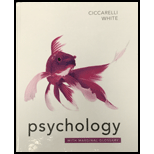
The term “stress” is used to define the emotional, physical, cognitive and behavioral responses originated due to challenging or threatening events. Marriage, car problems and so on are some specific stressors.
Pressure, uncontrollability, frustration, and aggression are some psychological reasons that people find such events stressful. Aggression consists of actions that causes harm and destroy another person due to frustration.
Answer to Problem 10TY
Correct answer:
A person comes home from work angry because of an argument he had with his boss. Subsequently, the person begins yelling at her wife for no apparent reasons. Ultimately, wife of the person finds herself yelling at their youngest child for apparently no good reason other than being frustrated. The wife of that person is displaying displaced aggression. This information is reflected in option “c”. Therefore, option c is correct.
Option c. is given as “displaced aggression”.
Explanation of Solution
Reasons for the correct statement:
Aggression in which one’s frustration is taken out on some less threatening or more available target is termed as displaced aggression. In the given case, wife of the person was frustrated by things that occurred in his office then he yelled at Kina for no reasons. It made wife of the person frustrated and he started to yell at his children. This is due to displaced aggression.
Hence, option c. is correct.
Reasons for the incorrect statements:
Option a. is given as “escape”.
Escape is another reaction of frustration that makes people to leave, drop the school and quit the job or end a relationship. Hence, it is a wrong answer.
Option b. is given as “withdrawal”.
Withdrawal is another reaction of frustration that makes people to leave, drop the school and quit the job or end a relationship, is also known as escape. Hence, it is a wrong answer.
Option d. is given as “projection”.
Projection can be defined as a psychologically mechanism in which, people response or act in order to handle the difficult emotions or feelings. Hence, it is a wrong answer.
Hence, options a., b., and d. are incorrect.
Displaced aggression occurs when one tries to take out their frustration due to other reasons, on someone who is less threatening or easily available to them.
Want to see more full solutions like this?
Chapter 11 Solutions
PSYCHOLOGY:MARG.GLOSS.-W/ACCESS>CUSTOM<
- https://www.newyorker.com/video/watch/rewriting-racist-headlinesarrow_forwardWhich of the following are examples of physical maturation influencing cognitive growth? Select all that apply. Physical growth occurs independent of other systems and has little bearing on cognitive processing. As language develops, interaction increases, manipulation of objects including improving fine motor skills, which in turn influences both physical and cognitive abilities. Which of the following are examples of physical maturation influencing cognitive growth? Select all that apply. Physical growth occurs independent of other systems and has little bearing on cognitive processing. As language develops, interaction increases, manipulation of objects including improving fine motor skills, which in turn influences both physical and cognitive abilities. Language acquisition depends on physical development of the brain and vocal cords facilitating learning language and increasing thought processes. Ability to crawl or walk to explore one’s environment increases learning…arrow_forwardWhich statements are true concerning sibling interaction that affects a healthy childhood? Select all that apply. There is no evidence that sibling rivalry and sibling abuse has any long-term effect on children. Some research suggests that one’s personality can be influenced by where you are in the “birth order” of the family. The more children in the home the greater the influence of “birth order” on all the children and future careers. Older siblings can help their younger siblings learn concepts by supporting them during a difficult task, known as scaffolding.arrow_forward
- Creativity and intelligence seem to be linked, and recent research appears to support this idea. Including creativity in assessments of intelligence may offer a way to counter issues of test bias. What are your ideas regarding how to educate others and advocate for these changes to be made?arrow_forwardWhat page number in the book tangerine is paul asking himself whats wrong with him when he doesnt tell his parents about Erikarrow_forwardWhat page number in the book tangerine by edward bloor is paul is asking himself whats wrong with him when he doesnt tell his parents about erikarrow_forward
- I need help finding 20 interesting research peer review articles on evolutionary psychology& culturalarrow_forwardWhat are three methods for dissemination of information that school counselors can use after learning from the modules of the “504 Online Introductory Tutorial” (https://sss.usf.edu/resources/topic/section504/504course/Module1/index.html Bureau of Exceptional Education and Student Services (2015))? Please write in a narrative format and include in-text citations and references.arrow_forwardWhat are three professional best practices that school counselors can implement or can recommend in schools from the modules of the “504 Online Introductory Tutorial” (https://sss.usf.edu/resources/topic/section504/504course/Module1/index.html Bureau of Exceptional Education and Student Services (2015))? Please write in a narrative format and include in-text citations and references.arrow_forward
 Ciccarelli: Psychology_5 (5th Edition)PsychologyISBN:9780134477961Author:Saundra K. Ciccarelli, J. Noland WhitePublisher:PEARSON
Ciccarelli: Psychology_5 (5th Edition)PsychologyISBN:9780134477961Author:Saundra K. Ciccarelli, J. Noland WhitePublisher:PEARSON Cognitive PsychologyPsychologyISBN:9781337408271Author:Goldstein, E. Bruce.Publisher:Cengage Learning,
Cognitive PsychologyPsychologyISBN:9781337408271Author:Goldstein, E. Bruce.Publisher:Cengage Learning, Introduction to Psychology: Gateways to Mind and ...PsychologyISBN:9781337565691Author:Dennis Coon, John O. Mitterer, Tanya S. MartiniPublisher:Cengage Learning
Introduction to Psychology: Gateways to Mind and ...PsychologyISBN:9781337565691Author:Dennis Coon, John O. Mitterer, Tanya S. MartiniPublisher:Cengage Learning Psychology in Your Life (Second Edition)PsychologyISBN:9780393265156Author:Sarah Grison, Michael GazzanigaPublisher:W. W. Norton & Company
Psychology in Your Life (Second Edition)PsychologyISBN:9780393265156Author:Sarah Grison, Michael GazzanigaPublisher:W. W. Norton & Company Cognitive Psychology: Connecting Mind, Research a...PsychologyISBN:9781285763880Author:E. Bruce GoldsteinPublisher:Cengage Learning
Cognitive Psychology: Connecting Mind, Research a...PsychologyISBN:9781285763880Author:E. Bruce GoldsteinPublisher:Cengage Learning Theories of Personality (MindTap Course List)PsychologyISBN:9781305652958Author:Duane P. Schultz, Sydney Ellen SchultzPublisher:Cengage Learning
Theories of Personality (MindTap Course List)PsychologyISBN:9781305652958Author:Duane P. Schultz, Sydney Ellen SchultzPublisher:Cengage Learning





